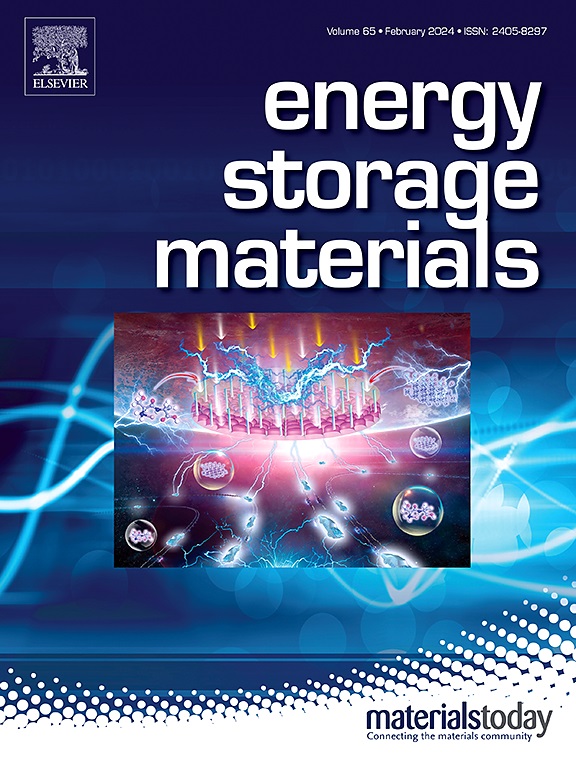Synergistic ionic-molecular coordination engineering in weakly solvating ether electrolytes for stable high-voltage lithium metal batteries
IF 18.9
1区 材料科学
Q1 CHEMISTRY, PHYSICAL
引用次数: 0
Abstract
Lithium metal batteries (LMBs) face critical challenges such as uncontrolled Li dendrite growth, unstable interfaces, and irreversible inactive Li formation. This study proposes an ionic-molecule synergistic electrolyte engineering strategy utilizing a weakly solvating electrolyte (WSE) with dual additives—lithium nitrate (LiNO₃) and tris(pentafluorophenyl)borane (TPFPB). The molecular interactions between TPFPB and NO₃⁻ allow LiNO₃ to be effectively dissolved in DOX. Meanwhile, TPFPB coordinates with FSI⁻ anions to facilitate salt dissociation. These processes optimise the solvation structure towards contact ion pairs (CIPs) and aggregates (AGGs). Density functional theory (DFT) calculations and molecular dynamics (MD) simulations confirm that the solvation structure has been effectively optimized through the introduction of synergistic additives, which promotes the formation of inorganic-rich interfacial layers to protect both the anode and the cathode. Consequently, Li||LiFePO₄ cells maintain 98.14 % capacity retention over 480 cycles at 1 C. Moreover, a full battery assembled with high-loading LiNi0.8Co0.1Mn0.1O2 cathode (1.82 mAh cm⁻²) coupled with ultrathin Li anode (50 μm) retains 88.0 % capacity after 250 cycles under high-voltage operation (4.4 V). This work elucidates an ionic-molecular coordination paradigm for WSE design, providing insights into next-generation electrolyte engineering in practical high-energy-density lithium metal batteries. Furthermore, the proposed strategy holds broader implications for the development of other metal-based battery systems, including but not limited to Na, K, Mg, and Zn multivalent ion systems.


稳定高压锂金属电池弱溶剂化醚电解质的离子-分子协同工程
锂金属电池(lmb)面临着诸如不受控制的锂枝晶生长、不稳定的界面和不可逆的非活性锂形成等严峻挑战。本研究提出了一种离子-分子协同电解质工程策略,利用弱溶剂化电解质(WSE)与双重添加剂-硝酸锂(LiNO₃)和三(五氟苯)硼烷(TPFPB)。TPFPB和NO₃之间的分子相互作用可以使LiNO₃有效地溶解在DOX中。与此同时,TPFPB与FSI相协调,以促进盐的分离。这些过程优化了接触离子对(cip)和聚集体(AGGs)的溶剂化结构。密度泛函理论(DFT)计算和分子动力学(MD)模拟证实,通过引入增效添加剂,溶剂化结构得到了有效优化,促进了富无机界面层的形成,从而保护了阳极和阴极。因此,锂||LiFePO₄电池在高温下480次循环保持98.14%的容量。此外,高负载LiNi0.8Co0.1Mn0.1O2阴极(1.82 mAh cm⁻²)与超薄锂阳极(50 μm)组成的完整电池在高压(4.4 V)下250次循环后保持88.0%的容量。这项工作阐明了WSE设计的离子-分子配位范式,为实际高能量密度锂金属电池的下一代电解质工程提供了见解。此外,所提出的策略对其他金属基电池系统的发展具有更广泛的影响,包括但不限于Na, K, Mg和Zn多价离子系统。
本文章由计算机程序翻译,如有差异,请以英文原文为准。
求助全文
约1分钟内获得全文
求助全文
来源期刊

Energy Storage Materials
Materials Science-General Materials Science
CiteScore
33.00
自引率
5.90%
发文量
652
审稿时长
27 days
期刊介绍:
Energy Storage Materials is a global interdisciplinary journal dedicated to sharing scientific and technological advancements in materials and devices for advanced energy storage and related energy conversion, such as in metal-O2 batteries. The journal features comprehensive research articles, including full papers and short communications, as well as authoritative feature articles and reviews by leading experts in the field.
Energy Storage Materials covers a wide range of topics, including the synthesis, fabrication, structure, properties, performance, and technological applications of energy storage materials. Additionally, the journal explores strategies, policies, and developments in the field of energy storage materials and devices for sustainable energy.
Published papers are selected based on their scientific and technological significance, their ability to provide valuable new knowledge, and their relevance to the international research community.
 求助内容:
求助内容: 应助结果提醒方式:
应助结果提醒方式:


